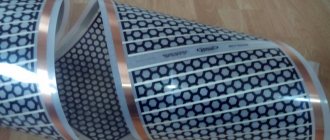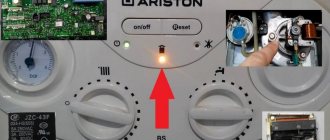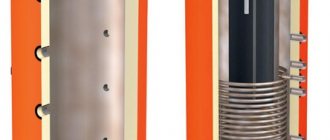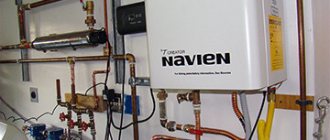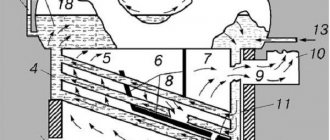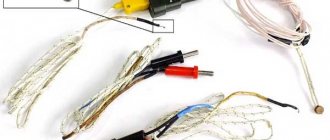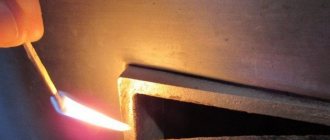How does a heat exchanger work?
A heat exchanger, or radiator, is designed to heat water from the burner.
The flow flows through the coil tubes, instantly warming up from the burning fuel. Most often the block is steel or copper. How much does the device weigh? Copper device - from 3 to 3.5 kg. The steel apparatus is much heavier, for this reason it has lower efficiency. Features of steel product:
- Lower cost compared to copper.
- Due to the plasticity of the material, heating does not harm the surface.
- It is resistant to corrosion.
Copper device:
- It has high efficiency and fast heating.
- Products that contain additional impurities are cheaper.
- Corrosion resistance.
- Light weight if it is pure copper.
Trying to reduce the cost of production, manufacturing companies add impurities to copper. Because of this, the radiator heats up unevenly, which leads to burnout of individual parts. Some people coat the surface with heat-resistant paint, but this brings little results. The service life does not exceed 2-3 years.
Copper is more resistant to corrosion than steel. Most manufacturers do not indicate how much copper is used to produce the product, convincing them that the heat exchanger is made of a thick layer.
To extend the life of the device, install water filters. They soften and clean the liquid from impurities that settle on parts in the form of scale.
How much does it cost to replace a gas boiler radiator? If you take into account the purchase of a new device, delivery and installation, it will be cheaper to repair the heat exchanger.
Popular manufacturers
Cast iron heat exchanger for Beleto floor-standing boiler
Heat exchangers are produced by many manufacturers. The most popular companies in 2022 were the following.
Navien
The largest Korean manufacturer. It produces products intended for household boilers. The advantage is resistance to low water quality and water hammer. The device is perfectly adapted to poor operating conditions.
Baxi
Italian manufacturer. Presents on the market wall-mounted and floor-mounted condensing boilers with a cast iron heat exchanger, as well as electric heaters.
The company makes primary heat exchangers from copper and brass. For secondary plates, stainless steel is used. This increases the cost of the products, but ensures maximum durability.
And others
There are other worthy manufacturers on the market:
- Fondital Victoria Compact is an Italian company. Offers high performance bithermic copper heat exchangers.
- Beleto is a well-known Russian plant that produces a variety of gas equipment. Manufactures steel, cast iron and copper heat exchangers of various types.
- Ariston - offers aluminum and copper heat exchangers. The materials are insensitive to corrosion, and the manufacturing technology guarantees their strength.
If there is a need to increase the efficiency of the boiler when replacing the device, consult a specialist to calculate the required parameters.
Classification of heat exchangers for boilers
Heat exchange elements for a gas boiler can differ significantly in design and use. The following devices are most often used in thermal equipment:
Primary
This category of devices is used to transfer thermal energy directly into the fuel combustion chamber.
Attention ! Primary heat exchangers are operated in very harsh conditions, so they must be made of very high quality materials.
Secondary
The secondary heat exchanger is heated by transferring energy from the coolant to another liquid.
This device is ideal for meeting the need for hot water in the presence of a separate heating circuit.
Bithermal
A bithermic heat exchanger is a modern and practical element of a heating boiler.
This design consists of 2 separate tubes installed one inside the other. Products of this type are used primarily for simultaneous heating of water for heating and domestic needs.
Purpose of the boiler heat exchanger
A heat exchanger is a basic operational component of boiler equipment that transfers heat received as a result of the combustion of main gaseous fuel. It is located near the burner device.
The walls of the device are made of metal with a good heat transfer coefficient. The coolant liquid washes the heating surface of the heat exchanger, heats up to a temperature of 65-95 C and enters the intra-house heating network.
The movement of the coolant to the heating radiators occurs naturally, due to the temperature difference between the heated and cooled coolant, or in a forced way, using a centrifugal pump. Passing through the heating system, the cooled coolant returns to the boiler for the next heating cycle
In modern energy-efficient boilers, plate designs are the most common. In them, stainless steel plates are securely soldered to each other at the points of contact and along the edges.
This 100% guarantees tight operation, without leakage or mixing of liquids from different heating circuits.
The preferred material for soldering in such structures is copper. The design prevents scale formation and corrosion on the heating surface of the boiler. This ensures economical operation of the boiler unit with high efficiency.
Material of manufacture
The heat exchanger for the boiler is made from durable materials that conduct heat well, are not prone to corrosion and are sufficiently resistant to pressure. Since the cost of the material also has to be taken into account, the choice is limited.
Steel
A steel heat exchanger is cheaper in price, but less durable.
This is the most affordable material. Steel is very strong, but can be processed well. The price is low. The advantage of this option is resistance to high temperatures. Steel is plastic and does not crack when heated, and does not deform even in areas in contact with the burner.
A steel heat exchanger for a solid fuel or gas boiler is prone to corrosion. Water inside the tubes and combustion products in the boiler chamber have a destructive effect on the material. This affects durability. The steel model weighs a lot, which leads to additional fuel consumption for heating the element itself.
The stainless steel heat exchanger is resistant to corrosion and lasts for at least 50 years.
Cast iron
The material is much more resistant to corrosion than steel, and is not afraid of rust and the action of acid anhydrides. The service life reaches 50 years. However, cast iron is a brittle alloy and can crack under the influence of temperature. To avoid damage, the cast iron tubular heat exchanger must be washed: if ordinary water is used, then once a year; if antifreeze - then once every 2 years; if distilled liquid - once every 4 years.
The weight of a cast iron element is even greater, so more fuel and time have to be spent on heating.
Copper
Copper is a noble metal that is not susceptible to any type of corrosion. It is chemically inert and tolerates pressure well. Copper conducts heat better, so less fuel is required to heat the element itself and the flowing liquid. The weight of the copper model is small, the dimensions are compact with a very developed working surface.
The disadvantage is the high price. Also, the copper heat exchanger is too sensitive to heating to high temperatures. More often found in boilers from foreign manufacturers.
Criterias of choice
The main parameter of a heat exchanger is its power.
When choosing a device, the purpose is taken into account - in this case it is heating the coolant, and the type of medium - steam, water, antifreeze. A gas boiler usually works with water, but there are exceptions.
Other selection criteria:
- Coolant temperature at the inlet and outlet - it is necessary to calculate how much heat the consumer should receive. Based on these data, the heat exchanger power is calculated.
- Allowable pressure losses - the water pressure decreases as it passes through the heat exchanger. If it falls too low, it will not be possible to create a column of hot water of sufficient height.
- The maximum operating temperature on the burner reaches 600–700 C. A cast iron and steel heat exchanger can withstand this temperature; copper heat exchangers can withstand this temperature with some difficulty. The aluminum model must not be used.
- Maximum operating pressure – does not limit the choice of design or material.
Dimensions are a significant parameter. With the same efficiency, a shell-and-tube heat exchanger occupies an area 3–4 times larger than a plate heat exchanger.
Correct operation
The heat exchanger is washed depending on the water hardness.
Transportation, installation and operation of the heat exchanger device are described in detail in the instructions:
- The heat exchanger is placed in the apparatus so that it has easy access for inspection and repair.
- Start-up is performed at stable pressure and temperature. Do not increase the temperature faster than 10 degrees per minute or increase the pressure more than 10 bar per hour.
- When filled with water, the air valves and valves behind the heat exchanger remain open. After the pump starts, they are closed. In this way, stable pressure is achieved.
- You need to change the heating parameters smoothly. The slower this happens, the longer the seals and the heat exchanger itself will last.
- The device needs to be cleaned periodically. The plate is cleaned directly in the frame, then the plates are removed and washed. Another method is possible: first removing and then cleaning the plates. It is not recommended to clean shell-and-tube machines. In case of complex blockages, the technician installs a plug.
- Before restarting, check the condition of all gaskets. Pressure and temperature are set as at 1st start.
To avoid salt deposits, a filter is placed on the water pipe in front of the boiler entrance.
What are its advantages of energy-dependent species
Non-volatile installations operate only on a mechanical principle, without needing to be connected to the power supply system.
This makes them indispensable in remote villages, in areas with dilapidated or overloaded electrical networks . Frequent shutdowns cause the heating to stop working, which is unacceptable in the Russian winter.
Non-volatile models ensure continuous heating of the house regardless of external conditions. However, such possibilities limit the capabilities of non-volatile boilers. They work only on natural physical processes - circulation of the coolant requires installation of the heating circuit at a slight angle and is based on the rise of warm layers of liquid upward.
Smoke removal occurs under the influence of normal draft in the chimney. It must be taken into account that natural processes occur with minimal intensity and are unstable, so external additional devices are usually installed - a turbo nozzle and a circulation pump.
They make the unit more productive, and operation in non-volatile mode occurs only during a power outage.
If there is no power supply to the house at all, only the basic capabilities of the unit are used.
Primary heat exchanger repair
The exchanger deteriorates due to poor quality coolant or the materials from which it is made, as well as other factors. Pressure, high temperatures and their differences lead to cracks, which is why the element begins to work less powerfully and breaks down over time. The life of the heat exchanger can be extended if purified water is supplied and the boiler is not overloaded.
We recommend: Installing a instantaneous water heater with your own hands: step-by-step instructions
It will be more difficult to eliminate cracks than clogs. The heat exchanger is soldered for this purpose. Select solder from the same material as the unit itself. Boiler heat exchangers are usually made of copper, less often cast iron or steel. Aluminum, silicon, manganese, nickel and zinc are added to the composition.
Leaks on the primary heat exchanger can occur due to exposure to flames, water hammer, and in some cases they are caused by corrosion
Additional solder requirements:
- melting point not lower than 700 °C;
- sufficient viscosity;
- fluidity is the same as that of a heat exchanger.
Copper-zinc solders are considered one of the best. They are used for soldering most non-ferrous metals with a higher melting point than the support material itself. Solders with inclusions of silicon or tin - up to half a percent - are safer for the human body.
It is better to avoid copper-phosphorus materials, and if exchangers are soldered with them, do so without any load such as shock or vibration. Well-chosen solder is half the battle.
Heat exchangers are soldered with gas burners and blowtorches. Before soldering, the desired area is cleaned with fine-grained sandpaper and wiped with a rag with a solvent, and then heated. The area is heated with a hairdryer or a weak burner/soldering iron. At this moment, the main thing is to get into the temperature corridor and take into account subsequent cooling. Barely noticeable damage is found by small greenish spots.
Before heating, the water is drained, and its remains are removed with a compressor or blown out through a flexible hose. The hose is fixed by thread if it has a union nut and the design features allow this. If you leave water, it will take away part of the thermal energy.
Solder spools: At high temperatures, the material wets the base and spreads across it, gets into the smallest gaps and stretches, resulting in an intermediate layer of base and solder combination
Solder is preferred in the form of a wire or rod: when soldering, the molten end will be well immersed in the flux, which will stick to it. If the wire lays on the exchanger itself too intermittently or loosely, the preheating was weak. After work, the soldering area is sometimes coated with heat-resistant paint for better insulation.
Over the next two weeks, the soldered area is checked daily for integrity. At the first detected leak, you should contact a specialist. If it appears in the first fortnight, it means the soldering was of poor quality.
The flux is suitable for universal use, as well as gel soldering flux. Avoid rosin, unusual options like aspirin and others.
Repair of secondary heat exchanger
Secondary heaters often clog, especially models with narrow channels. Without cleaning, they break down over time and finally fail. A layer of scale inside the unit reduces heat transfer, causing the boiler to consume more gas.
Salt deposits, scale and rust form the bulk of the contamination: in addition to the secondary heat exchanger, it doesn’t hurt to also check the heating and hot water circuits
Problems with heat exchangers will be indicated by codes on the boiler display. There is an action plan for this case.
Let's take a closer look at the problem with the secondary heater:
- We take out the secondary heat exchanger.
- We look at the joints, internal and external threads. After the last cleaning, their condition may have worsened. This happens due to aggressive acids. We replace worn out removable elements.
- We check the integrity. The heat exchanger could experience a water hammer. Only a specialist will find a very small fistula (hole).
- We better inspect the exchanger, and for this we call a specialist. We replace a severely damaged unit.
- Even at the very beginning, contamination can be found. We look for plaque visually in the inlet openings. We blow air into the part and also focus on the sound. We clean it if the exchanger is clogged. Pieces of scale may fall out of it even after a slight knock.
- You need to choose 1 of 3 cleaning options: home remedies like detergents and solutions with citric acid, special mixtures, or professional cleaning.
First of all, rinse the exchanger with a stream of water from a cold tap. Then pour citric acid into the device and place it in a bucket of water. Afterwards, take out the heat exchanger and pour water into it to check the permeability.
If it comes in slowly or does not move, then prepare a saturated solution of vinegar in water and pour it there. Then rinse with hot water and blow off. If possible, use an air pump. Do several cycles with vinegar.
Among the arguments for professional cleaning, it is worth noting the inconvenience of the design for cleaning, difficulties in assessing contamination, and the risk of damage due to independent mechanical action
If the steps described do not help, try special cleaning solutions: cleaning gel or low-percentage adipic acid solution. If this method does not work, then call a specialist or order professional cleaning.
Number of circuits in the device
The boiler can have one or two operating circuits built into it. In the first case, the device will only heat the coolant, that is, function as a heating device.
Such equipment is equipped with one heat exchanger, which significantly simplifies its design and reduces its size. True, the latter also depends on the power of the device. If single-circuit equipment is installed, you will need to purchase an additional unit to heat the water.
In this case, you can additionally install an indirect heating boiler, for example, or any other device. Single-circuit boilers are chosen for heating objects that do not require hot water supply or for large houses, where all the power of the device will be used to heat the building.
Double-circuit models are capable of simultaneously heating the coolant and heating water for domestic needs. Double-circuit boilers have two heat exchangers built in, which significantly complicates the design.
There are models with a so-called bithermic heat exchanger, which is divided into segments. The coolant moves through one of them, and the heating water moves through the other. Such devices are as compact as possible, but less reliable and easy to use.
The best option can be considered units with two completely separate heat exchangers. They form less scale. In addition, the circuits are separated, so there is no need to shut off the heating segment when distributing hot water. Whereas in boilers with a bithermic heat exchanger this is exactly what happens.
Double-circuit boilers are optimally used for small residential buildings. In large areas, mandatory separation of circuits is required, which is due to safety requirements, lack of total power, etc.
Disturbances in the operation of the column and their elimination
If your water heater suddenly leaks, sometimes the reason is worn out gaskets. When removing the casing, it becomes clear whether this assumption was justified. Having found a fistula in the heat exchanger, many consumers are interested in how to replace the problematic part. But the difficulty is that the price of spare parts reaches 30% of the price for a completely new heater.
It is much more practical to solder a mechanical defect using a soldering iron. Solder melts at about 200 degrees. The exact value is determined by the brand of the specific part. Even if the water boils for a long time, it will not damage the integrity of the “patch.” This solution is equally relevant for Russian and foreign speakers. After all, the risk of breakdown is present everywhere, only the service life differs, but defects will still appear in any model.
Reasons for heat exchanger failure
The period of operation is determined primarily by how the water in the city water supply is disinfected. In Russia, either pure chlorine or chlorine dioxide is used. When the water flowing through the copper tube heats up, it causes a violent chemical reaction. Copper chloride is inferior to pure metal in strength, and therefore fistulas appear quite quickly. The luckiest people are residents of cities where tap water is ozonated.
Recommend: Heat Resistant Oven Sealant, High Temperature Chimney Sealant
But there are still very few such settlements. The high cost of the modern solution does not allow us to count on the rapid spread of ozonation. Moreover, now manufacturers have begun to save in every possible way. And if previously troubles happened quite rarely with thick tubes of heat exchangers, now thin, low-quality copper is used everywhere. The service life of products has significantly decreased.
The process of replacing a heat exchanger with your own hands
To save money, many users decide to replace the heat exchanger in a gas boiler with their own hands. It’s worth noting right away that you shouldn’t try to solve the problem by soldering the hole that appears - this will extend the life of the heat exchanger by no more than 2-3 months. It is better to call a service center specialist or purchase a new circuit and perform the replacement yourself. The sequence of actions when carrying out repairs with your own hands is as follows:
- turn off the gas;
- disconnect the unit from electricity;
- disconnect the boiler from the water lines and prepare a bucket in case the remaining water leaks out;
- use a screwdriver to remove the unit cover;
- check according to the diagram in the instructions where the heat exchanger is located;
- disconnect the circuit and take it to the store to buy a new one, or immediately screw on a working element if available;
- connect the gas boiler to all previously disconnected communications;
- let in coolant to check the tightness of the system;
- If everything is normal, close the boiler body and screw in the removed bolts.
Replacing the circuit in a gas boiler with your own hands is quite possible, but it requires some accuracy and a clear sequence. If this manipulation seems too complicated, call a specialist - he will save you the unnecessary hassle of finding a suitable part, do everything quickly and provide a guarantee for his work.
Branding is an important point
Look at the specific branding of the boiler itself. It is a rare manufacturer that makes a specific product from scratch to the final result. Usually he orders some specific parts from outside. So, almost always wall-mounted gas boilers are made entirely from some third-party components. Then the manufacturer himself assembles everything into a single design at his factory, finalizes the software, arranges everything as needed and releases everything in a beautiful form. A good manufacturer will always show what his gas boiler is made of. He can write about this in his brochures, sketch out what the boiler is made of, but sometimes he remains silent. But in this case, looking into the boiler, you will definitely see what the boiler is made of, everything will be written on every detail. If you see a branded wall-mounted gas boiler, you can consider purchasing it. This is a good option for your home. If you look into the boiler and do not understand what it is made of, the manufacturer is trying to hide what parts are used. In such cases, simply write the part marking, production date and serial number. It is better not to buy such gas boilers. If the boiler is made of good parts, the manufacturer will always want to say so.
Branding example. The fan has a label from the Polish manufacturer Fime.
These five points should help you choose a gas boiler that will delight you in your home for many years, will not create problems and will last long enough.
How to clean the heat exchanger of a gas boiler
To clean the heat exchanger from scale, mechanical, chemical and magnetic cleaning methods are used. The first option is performed using a cleaning rod and scraper.
Tools can be manual or electric. The chemical option involves the use of crustacean chemicals that can loosen and dissolve contaminants.
To flush the heat exchanger using this method, use a special pump circuit and a flushing agent specified by the manufacturer, for example, for a Baxi gas boiler.
Algorithm for cleaning the heat exchanger from scale:
- Turn off the boiler.
- Prepare liquid for flushing heat exchangers of gas boilers according to the manufacturer’s recipe.
- After complete cooling, utility networks are disconnected from it and the water is drained.
- Remove the tie rods, move the pressure plate aside and then carefully remove each plate one by one. The work is carried out with gloves so as not to injure your hands.
- When working with acid, change gloves to rubber ones.
- Prepare a container for cleaning the plates so that they are completely covered with the working solution.
- The plates are immersed in the composition for 1 hour, after which the remaining deposits are removed under tap water using a brush.
- Assembly of the cleaned structure is carried out in the reverse order.
After washing the heat exchanger, check the tightness of the boiler under the operating pressure of the coolant. All utilities, gas and electricity are connected and the equipment is started for the first time after flushing.
If a leak is detected, it is necessary to tighten the nuts or install a new gasket on the heat exchanger.
Monothermic or bithermic
When the boiler is capable of operating only in heating mode, it is called single-circuit. But many modern models are also capable of operating in hot water supply (DHW) mode. Such boilers are called double-circuit boilers. Water can be heated in two ways: using a plate heat exchanger or bithermic.
The plate heat exchanger is installed separately from the main one and consists of two parts. When heating water passes through one part, it heats the second, which is connected to the water supply. This is a separate, more practical and reliable, but more expensive and less compact method.
The bithermal heat exchanger cannot be cleaned mechanically and is quite difficult to rinse. When scale forms, it clogs faster.
In order to save money and space, dual or bithermal heat exchangers were invented. Their operating principle is completely different. Structurally, this is one piece: a heat exchanger in a heat exchanger or a pipe in a pipe. Heating is usually carried out outside, and a hot water supply circuit is located inside.
Unfortunately, due to their design, bithermal heat exchangers have narrow passages that can quickly become clogged. But cleaning doesn’t always help, and it’s not so easy to do. The price of such heat exchangers is much higher. And you will still have to use water for a limited time, since there is a risk of burning through the metal. I believe that it is better to buy boilers with separate heat exchangers. They are more reliable.
Heat exchanger of a gas boiler in section. The use of contaminated coolant and lack of regular cleaning led to serious consequences: serious overheating and almost complete clogging.
Conclusion
People buy a boiler for more than one year. In the worst case, it should last several years
And since the heat exchanger is an important part of any boiler, its selection must be approached carefully. It is also worth remembering that this is one of the most expensive and difficult to replace spare parts.
It is better to monitor the correct operation of the equipment and service it annually than to pay extra money for repairs later.
How to extend the life of a heat exchanger?
In order for the heat exchanger to work as long as possible, a number of specific recommendations should be followed:
- Install a filter on the tap water supply - this will prevent the accumulation of lime deposits inside the circuit and minimize the effects of corrosion.
- Clean the heat exchanger in a timely manner, especially for units that are not equipped with water filters. The part must be cleaned regularly once every 2 years, if there is filtration - once every 4-5 years.
- Do not use the maximum operating mode of the burner all the time.
When choosing a gas boiler for a house or apartment, take into account the fact that heat exchangers made of cast iron or copper are considered the most durable.
Requirements for boilers
Floor standing units are great for heating large homes. Installing this device often requires distributing the coolant over several rooms and floors. To choose the right equipment, you need to mentally imagine the location of the pipes. This will help you avoid making a mistake with your purchase.
Models of this type have a significant mass, so the device needs to be equipped with a solid base. It is not necessary to fill a wooden floor with concrete; you can cover it with sheets of galvanized iron.
The following requirements apply to boilers:
- The presence of a mechanism for adjusting power.
- Elements of protection and control.
- Economical fuel consumption.
- Small dimensions and acceptable weight.
- Installation and installation must be carried out efficiently and in accordance with all rules. It is recommended to entrust this work to a specialist.
- The unit must be connected to a chimney; if it is not equipped with a forced draft, you need to check the draft yourself.
Malfunctions, repairs
Gas heaters have light indication. It is intended to notify of malfunctions. Each manufacturer creates its own character code contained in the passport. If you don’t have a passport, you can download it on the Internet. Malfunctions can be divided into two categories:
- those that can be eliminated on your own;
- requiring specialist intervention.
What you can fix yourself is not specified in the passport. Common heat exchanger failures:
- depressurization;
- blockage
Elimination of leaks is carried out with a soldering iron, welding, depending on the metal. The second malfunction occurs due to poor-quality coolant, scale. Eliminated by washing. To remove scale, you can use phosphoric acid or citric acid. The first one is more effective. How to do it is shown in the video:
Sometimes there is a manufacturing defect, but more often the malfunction occurs due to improper use of the devices. If you strictly follow the manufacturer's recommendations, the product will last a long time and with high quality. Boiler repair:
Washing methods
There are simple variations that practically do not involve any expenses, there are budget ones with minimal investments, and professional ones - they cost much more, but are highly effective.
How to flush the secondary heat exchanger of a gas boiler in one way or another? And when is it logical to use them. It all depends on the volume of deposits.
In the simplest situation, mechanical cleaning is sufficient. The outside of the VT ribs are cleaned. The work uses any hard brush, spatula, scraper or cable. It is very important here not to damage the plates.
The second method is washing with a special composition. In practice, it is combined with the first method and follows immediately after it.
The part is placed in a container with an acid mixture. Type of acid used: hydrochloric or citric. Suitable proportions: 100 grams per 10 liters. Water.
Acids can be replaced with any anti-scale preparations. After 30-40 minutes, the VT is removed from the container. The remaining scale is carefully wiped off.
At the same time, the coil is also cleaned. A special steel brush is used here.
The third method is chemical. More aggressive substances are pumped through the VT using a special pump. It attaches to the pipes of the part.
We recommend: Operating pressure in the heating system in a private house: what should it be, how to create it?
Suitable tools for the job are shown in this table:
| Facilities | Description | Proportion to water: grams: liter | Water temperature | Product price (RUB) |
| Lemon acid | Popular folk remedy | 100 : 10-12 | 50-70°C | 50 – 1 sachet. |
| Thermagent Active | A versatile liquid with a powerful effect | 1 : 9 | 40-50°C | 1500 – 10 kg canister. |
| STEELTEX Cooper | One of the most effective preparations, but suitable for working with light alloy parts | 1:6 to 1:10 | 40-60°C | 1300 – 5 kg capacity |
| Detex | Concentrate with effective biological substances. Excellent cleaning of steel, cast iron and copper parts | 200-500 :10 | 40-50°C | 4900 – 10 l canister. |
| Hydrochloric acid | Effectively removes heavy scale | 100 : 10 | 50-70°C | 50 – 1 kg |
A hose is placed in the container with the mixture almost to the very bottom, one side connected to the VT, and the other to the pump. This creates the necessary circulation. The procedure lasts 30-40 minutes. Then the part is thoroughly washed with plain water.
The fourth method does not involve extracting the component. This is a hydrodynamic flushing of the secondary heat exchanger of a gas boiler. But it is carried out only by professionals. This requires special technology and compliance with safety criteria.
Its principle is to run a special composition through the boiler system under powerful pressure (1.5-2 bar). The work is done by a booster. Abrasive elements are added to the cleaning liquid.
This is the most effective method, gently removing all deposits and cleaning the part to a commercial appearance.
If you doubt the success of self-cleaning, you can order this service. All operations are carried out within a day. Their price tag is determined by the following factors:
- region,
- power and boiler modification,
- company's markup,
- the equipment and chemicals used.
In Moscow and the central region, clients pay about 3,500-9,000 for services. In St. Petersburg - 3,000 - 7,000 rubles. In other regions: 1700 – 4500 rubles.
Choosing a burner for the boiler and the type of combustion chamber
There are several types of burners: atmospheric and fan. The first assumes the presence of an open burner, into which oxygen enters from the room. A standard chimney is used to remove combustion products.
If the gas boiler is a closed type, then in this case a fan burner is used. The built-in ventilation system forces air from the street into the structure through a coaxial pipe. The smoke is discharged through this pipe. This type of burner is efficient to use and can withstand pressure changes in the system.
There are also several burners distinguished by the method of switching on: with electric ignition and piezo. In the first option, the igniter is activated only at the moment of fuel supply, and when using a piezo, the igniter burns constantly.
When using electric ignition, an electrical connection is required. You should purchase a surge protector to protect against possible voltage surges.
Booster Summary
This is very rare and expensive equipment. If you intend to buy it, then you will expect expenses in the range of 40,000 - 90,000 rubles. And for everyday tasks this is a rather unprofitable solution.
The booster itself is a container with a built-in pump that provides a change in the flow vector. Because of this, the efficiency of washing increases significantly. The devices are resistant to any reagents.
The most popular models are presented below:
| Booster | A country | Productivity (liters per hour) | Tank volume (l) | Working pressure (bar) | Price tag (RUB) |
| PIPAL PUMP ELIMINATE 20 V4V | Italy | 2600 | 18 | 1 | 38 000 |
| BWT Cillit SEK 28 | Germany | 2400 | 20 | 1,5 | 57 000 |
| TM Aquamax | Italy | 5000 | 30 | 1,2 | 53 500 |
Actions for models of different brands
In general, there are few differences here. They relate to the disassembly of equipment and the use of one or another cleaning method. Available specifics regarding models of different brands are reflected below:
The first one is Navien. Any substances other than hydrochloric acid solution are suitable for washing VT. It greatly damages and even etches surfaces.
The second is Ariston. When flushing them, the maximum permissible pressure should be used, especially when working with a booster. In general, any drugs are suitable for the procedure. For light stains, acetic acid is recommended.
The third one is Baxi. There are no special criteria. This is a popular brand with service points in many cities. This way the service is cheaper.
The fourth is Vaillant. Here, as a rule, a copper VT is installed. For light contamination, use citric or acetic acid. In more severe cases, use the drug Aquamax.
Fifth - Beretta. In mild situations - hydrochloric acid. In extreme cases, the drugs Descalex and Remokal, as well as the Hydroflow cleaning system, effectively help.
Sixth – Ferroli. In many cases, adding hydrochloric acid helps. A more effective method: the same acid is heated in a booster to a temperature of 35-40 degrees. The cleansing process starts. This is a budget option. The more expensive one is associated with the use of special drugs.
Seventh - Junkers. Simple stains can be removed with hydrochloric or citric acid, or any anti-scale agent. In complex cases, pumping of the cleaning composition, heated to 50 degrees, with a circulation pump is required.
Eighth - Neva Lux. A citric acid solution is prepared according to the correct procedure, and the extracted VT is placed in it for 10-20 minutes. Then rinses thoroughly. In many cases, this method brings the desired effect. Difficult blockages are removed using a hydrochemical method using a booster.
The ninth is Viessmann Vitopend 100. For simple and complex solutions, any product that does not contain chlorides is suitable. Antox 75 E is particularly effective.
Tenth - Fondital Tahiti. For simple stains, any standard solutions are used (acids, descaling agents, special preparations). If standard solutions do not help, change the seal of the secondary heat exchanger of the Fondital Tahiti gas boiler. If the repeated result is negative, the VT itself changes.
There is a universal method for cleaning parts of all brands - hydrochemical. A booster and pumping system, and special reagents are required.

